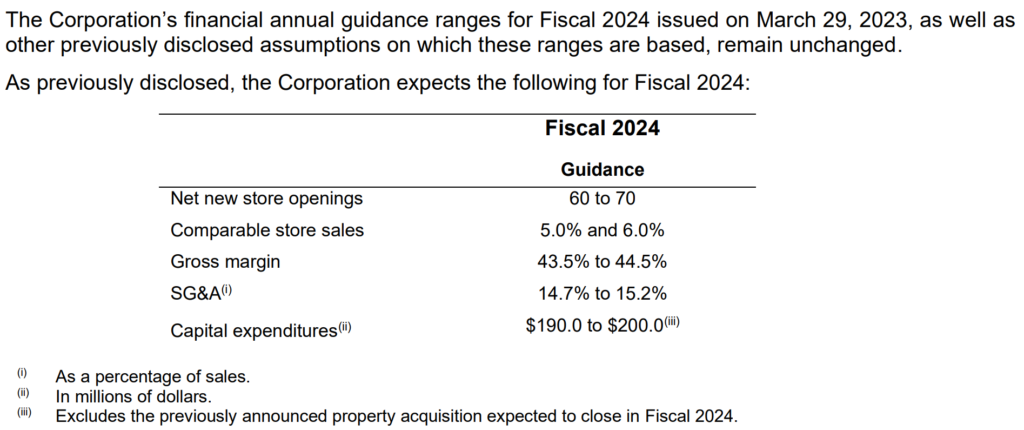Last updated by BM on June 12, 2023
Summary
- This is a weekly installment of our MP Market Review series, which provides updates on the financial markets and Canadian dividend growth companies we monitor on ‘The List’.
- Last week, ‘The List’ was down slightly with a YTD price return of +4.2% (capital). Dividend growth remained the same and is now at +8.4% YTD, highlighting growth in income over the past year.
- Last week, no dividend increases from companies on ‘The List’.
- Last week, one earnings report from companies on ‘The List’.
- One company on ‘The List’ is due to report earnings this week.
- If you’re interested in creating your own dividend growth income portfolio, consider subscribing to our premium service, which grants you access to the MP Wealth-Builder Model Portfolio (CDN) and exclusive subscriber-only content. Learn More

Introduction
“You have a pair of pants. In the left pocket, you have $100. You take $1 out of the left pocket and put it in the right pocket. You now have $101. There is no diminution of dollars in your left pocket. That is one magic pair of pants.”
This ‘magic pants’ analogy was from a Seeking Alpha article on dividend investing I read about a decade ago and was one of the catalysts for me to take a closer look at this type of investing and see if it truly was magical.
After conducting additional research, I have shifted towards utilizing a dividend growth investing (DGI) strategy as my primary investment approach. While I maintain portfolios consisting of high-quality dividend growers from both the United States and Canada, I have opted to concentrate on Canadian (CDN) dividend growth companies in this blog. This is due to several reasons, including a smaller pool of DGI companies to track, a lack of coverage for the DGI strategy by the North American investment media, and a tendency for those who do cover DGI to narrowly focus on only a handful of sectors (Energy and Financials).
While ‘The List’ is not a portfolio in itself, it serves as an excellent initial reference for individuals seeking to diversify their investments and attain higher returns in the Canadian stock market. Through our blog, we provide weekly updates on ‘The List’ and offer valuable perspectives and real-life examples of the dividend growth investing strategy in practice. This helps readers gain a deeper understanding of how to implement and benefit from this investment approach.
DGI Thoughts
“Inflation may have become the oldest form of government finance. It may also have been the oldest form of political confidence game used by leaders to exact tribute from constituents, older even than taxes, and inflation has kept those honoured places in human affairs to this day…For at least four thousand years of recorded history, man has known inflation.”
– Jens O. Parsson, Dying of Money
With inflation still in the news after another interest rate hike last week from the Bank of Canada, I thought it timely to revisit how above average inflation rates impact retirees.
You’ve probably come across the 4% Rule and the Age Rule when it comes to retirement planning. Let’s take a closer look at each of these rules.
The 4% Rule suggests withdrawing or spending down 4% of your assets each year. For example, if you have a $1,000,000 portfolio, you would withdraw $40,000 annually, which should ideally sustain you for 25 years of retirement. However, it’s important to note that the 4% Rule primarily works in a prolonged bull market characterized by consistent stock price growth. During an extended bear market, where stock prices decline, relying on withdrawals can significantly impact your portfolio and jeopardize your retirement savings.
The Age Rule determines the allocation of a person’s portfolio between stocks and bonds. It suggests subtracting your current age from 100 to determine the percentage of your portfolio that should be invested in stocks. For instance, if you retire at age 65, subtracting 65 from 100 gives you 35%, which should be allocated to equities, while the remaining 65% is invested in bonds and cash. As you age, the equity portion of your portfolio decreases, aiming for more stability. By age 80, it would decline to 20%.
In an inflationary environment, relying solely on a bond and cash portfolio may not sustain you throughout retirement unless you possess considerable wealth. Bonds typically do not increase their yield over the bond’s lifespan. If you purchased a Treasury bond ten years ago with a 2% yield, it would still pay you the same 2% when it matures. However, the purchasing power of that yield would be lower due to inflation. The goods and services you could have obtained with that bond ten years ago would cost more today, eroding its value.
Considering that neither rule functions optimally in a bear market or endures high inflation, retirees face a challenging dilemma. So, what can retirees do in such circumstances?
A better solution, I believe, is to own high-quality, dividend-growth stocks. In my opinion, they are the best inflation hedge that I know of that can help you keep pace with inflation and build your wealth. Predicting what my dividends will be at the end of the year has proven much more reliable than what the value of my portfolio will be. In the end, I know that eventually, my dividend growth will drive my capital growth, and I have a high probability of never running out of money in my retirement.
Here are two posts that discuss dividend growth investing and a withdrawal strategy in more depth.
If you have not yet joined as a subscriber of the blog to receive DGI Alerts on the activity and content related to our model portfolio, it’s not too late. Click Here.
Recent News
Bank of Canada hikes rate as it seeks to cool resilient economy (Globe & Mail)
“The Bank of Canada was forced to make a U-turn after Governor Tiff Macklem announced a “conditional pause” to interest-rate increases earlier this year when the central bank believed that borrowing costs were high enough to cool the economy and bring down inflation.”
Not a good sign! Makes you wonder if these guys really know what they are doing.
Happy bull-market days are here again – sort of (Globe & Mail)
“Oops. Rather than slowing, the economy continued to roar ahead in the first quarter. In April, inflation ticked higher, not lower. The Bank of Canada was forced to acknowledge in a statement on Wednesday that “concerns have increased” that inflation could “get stuck materially above the 2-per-cent target.” So it decided to make a U-turn and start raising interest rates again.”
Be careful what you glean from the financial news. This article correctly states that nobody really knows which way the economy is headed but if you stopped reading at the headline you may have missed the message from the article.
We continue to take advantage of the sensible prices a downward market provides by continuing to build our model portfolio and enjoy the rising income from our dividends. In case you missed it, the author did give a shout out to dividend stocks near the end of the article but as usual fails to differentiate between dividend growth stocks and dividend stocks.
To receive breaking news about companies on ‘The List’ follow us on Twitter @MagicPants_DGI.
The List (2023)
Last updated by BM on June 9, 2023
The Magic Pants List contains 27 Canadian dividend growth stocks. ‘The List’ contains Canadian companies that have raised their dividend yearly for at least the last ten years and have a market cap of over a billion dollars. Below is each stock’s symbol, name, current yield, current price, price return year-to-date, current dividend, dividend growth year-to-date and current dividend growth streak. Companies on ‘The List’ are added or subtracted once a year, on January 1. After that, ‘The List’ is set for the next twelve months. Prices and dividends are updated weekly.
| SYMBOL | COMPANY | YLD | PRICE | YTD % | DIV | YTD % | STREAK |
|---|---|---|---|---|---|---|---|
| AQN-N | Algonquin Power & Utilities | 5.9% | $8.65 | 28.5% | $0.51 | -29.0% | 12 |
| ATD-T | Alimentation Couche-Tard Inc. | 0.9% | $64.58 | 7.4% | $0.56 | 19.1% | 13 |
| BCE-T | Bell Canada | 6.2% | $61.37 | 1.9% | $3.82 | 5.0% | 14 |
| BIP-N | Brookfield Infrastructure Partners | 4.4% | $36.93 | 5.2% | $1.44 | 6.3% | 15 |
| CCL-B-T | CCL Industries | 1.7% | $63.01 | 8.5% | $1.06 | 10.4% | 21 |
| CNR-T | Canadian National Railway | 2.1% | $152.41 | -6.4% | $3.16 | 7.8% | 27 |
| CTC-A-T | Canadian Tire | 4.1% | $167.46 | 14.2% | $6.90 | 17.9% | 12 |
| CU-T | Canadian Utilities Limited | 5.0% | $36.12 | -2.2% | $1.79 | 1.0% | 51 |
| DOL-T | Dollarama Inc. | 0.3% | $83.03 | 4.0% | $0.27 | 23.8% | 12 |
| EMA-T | Emera | 5.0% | $55.33 | 5.2% | $2.76 | 3.0% | 16 |
| ENB-T | Enbridge Inc. | 7.0% | $50.62 | -5.1% | $3.55 | 3.2% | 27 |
| ENGH-T | Enghouse Systems Limited | 2.3% | $36.81 | 3.1% | $0.85 | 18.2% | 16 |
| FNV-N | Franco Nevada | 0.9% | $145.81 | 5.5% | $1.36 | 6.3% | 15 |
| FTS-T | Fortis | 3.9% | $57.42 | 3.8% | $2.26 | 4.1% | 49 |
| IFC-T | Intact Financial | 2.2% | $198.29 | 1.3% | $4.40 | 10.0% | 18 |
| L-T | Loblaws | 1.5% | $116.46 | -3.2% | $1.74 | 10.3% | 11 |
| MGA-N | Magna | 3.5% | $53.24 | -7.4% | $1.84 | 2.2% | 13 |
| MRU-T | Metro | 1.7% | $70.16 | -7.0% | $1.21 | 10.0% | 28 |
| RY-T | Royal Bank of Canada | 4.3% | $123.89 | -3.2% | $5.34 | 7.7% | 12 |
| SJ-T | Stella-Jones Inc. | 1.4% | $63.79 | 28.7% | $0.92 | 15.0% | 18 |
| STN-T | Stantec Inc. | 0.9% | $81.42 | 24.6% | $0.77 | 8.5% | 11 |
| TD-T | TD Bank | 4.9% | $79.12 | -9.8% | $3.84 | 7.9% | 12 |
| TFII-N | TFI International | 1.3% | $105.00 | 4.9% | $1.40 | 29.6% | 12 |
| TIH-T | Toromont Industries | 1.6% | $105.31 | 7.8% | $1.68 | 10.5% | 33 |
| TRP-T | TC Energy Corp. | 6.7% | $55.25 | 3.7% | $3.69 | 3.4% | 22 |
| T-T | Telus | 5.6% | $25.30 | -3.9% | $1.43 | 7.3% | 19 |
| WCN-N | Waste Connections | 0.8% | $135.83 | 3.1% | $1.02 | 7.4% | 13 |
| Averages | 3.2% | 4.2% | 8.4% | 19 |
Six Canadian stocks on ‘The List’ declare earnings and dividends in US dollars and are inter-listed on a US exchange in US dollars. The simplest way to display dividend and price metrics for these stocks is to show their US exchange symbols along with their US dividends and price. The stocks I am referring to have a -N at the end of their symbols. You can still buy their Canadian counterparts (-T), but your dividends will be converted into CDN dollars and will fluctuate based on the exchange rate.
Note: When the dividend and share price currency match, the calculation is straightforward. But it’s not so simple when the dividend is declared in one currency, and the share price is quoted in another. Dividing the former by the latter would produce a meaningless result because it’s a case of apples and oranges. To calculate the yield properly, you must express the dividend and share price in the same currency.
Performance of ‘The List’
Feel free to click on this link, ‘The List’ for a sortable version from our website.
Last week, ‘The List’ was down slightly with a YTD price return of +4.2% (capital). Dividend growth remained the same and is now at +8.4% YTD, highlighting growth in income over the past year.
The best performers last week on ‘The List’ were Magna (MGA-N), up +4.03%; Stella-Jones Inc. (SJ-T), up +3.99%; and Algonquin Power & Utilities (AQN-N), up +1.41%.
TFI International (TFII-N) was the worst performer last week, down -4.93%.
Dividend Increases
“The growth of dividend paying ability is of significance in the determination of a stock’s quality, or general safety…”
– Arnold Bernhard (the founder of Value Line)
“As a dividend increase is a positive sign of a company’s financial strength, the safest purchase, after research, is a stock with a recent dividend increase.”
– Tom Connolly (the founder of dividendgrowth.ca)
Last week, no dividend increases from companies on ‘The List’.
Earnings Releases
Benjamin Graham once remarked that earnings are the principal factor driving stock prices.
Each quarter we will provide readers with weekly earnings updates of stocks on ‘The List’ during the calendar earnings season.
The updated earnings calendar can be found here.
Earnings growth and dividend growth tend to go hand in hand, so this information can tell us a lot about the future dividend growth of our quality companies. Monitoring our dividend growers periodically is part of the process, and reading the quarterly earnings releases is a good place to start.
One earnings report from companies on ‘The List’ this week
Enghouse Systems Limited (ENGH-T) will release its second-quarter fiscal 2023 results on Monday, June 12, 2023, after markets close.
Last week, one earnings report from companies on ‘The List’.
Dollarama Inc. (DOL-T) released its first-quarter fiscal 2024 results on Wednesday, June 7, 2023, before markets opened.
“Canadians from all walks of life continue to respond positively to our compelling value proposition and affordable product mix. In the context of persistent inflationary pressure, we delivered a 17% increase in comparable store sales in the first quarter of Fiscal 2024. The first quarter also marked the opening of our 1,500th Dollarama store, a significant milestone as we pursue our target of 2,000 stores across Canada by 2031.”
– Neil Rossy, President and Chief Executive Officer
Highlights:
- 1% increase in comparable store sales
- 1% growth in EBITDA to $366.3 million, representing 28.3% of sales
- 6% increase in diluted net earnings per share
- Publication of comprehensive annual 2023 ESG Report in alignment with SASB standards and TCFD recommendations
Outlook:

These guidance ranges are based on several assumptions, including the following:
- The number of signed offers to lease and store pipeline for the next nine months and the absence of delays outside of our control on construction activities
- No material increases in occupancy costs in the short to medium term
- Continued positive customer response to our product offering, value proposition and in-store merchandising
- Approximately three months of visibility on open orders and product margins
- The active management of product margins, including through pricing strategies and refreshing some of the product offering
- The continued stabilisation of our supply chain and logistics environment
- The inclusion of the Corporation’s share of net earnings of its equity-accounted investment
- The entering into of foreign exchange forward contracts to hedge the majority of forecasted purchases of merchandise in U.S. dollars against fluctuations of the Canadian dollar against the U.S. dollar
- The continued execution of in-store productivity initiatives and the realization of cost savings and benefits aimed at improving operating expense
- The absence of a significant shift in labour, economic and geopolitical conditions or material changes in the retail competitive environment
- No significant changes in the capital budget for Fiscal 2024 for new store openings, maintenance capital expenditures, and transformational capital expenditures, the latter being mainly related to information technology projects and which budget excludes the purchase price for the previously announced property acquisition
- The successful execution of our business strategy
- The absence of pandemic-related restrictions impacting consumer shopping patterns or incremental direct costs related to health and safety measures
- The absence of unusually adverse weather, especially in peak seasons around major holidays and celebrations
Many factors could cause actual results, level of activity, performance or achievements or future events or developments to differ materially from those expressed or implied by the forward-looking statements. This guidance, including the various underlying assumptions, is forward-looking and should be read in conjunction with the cautionary statement on forward-looking statements.
Source: (DOL-T) Q1-2024 Earnings Release

